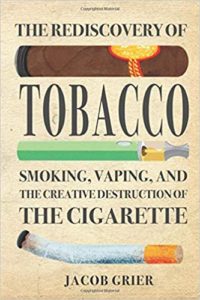
When I taught benefit‐cost analysis at the Naval Postgraduate School, one of the first principles I explained was that, to do a good analysis, you need to consider the costs and benefits to the various people affected rather than taking as gospel the desires of policymakers. We studied both good and bad examples of benefit‐cost analyses. In the bad ones, a common error was to leave out the gains to consumers when they consumed items that policymakers did not want them to. A typical case was alcoholic beverages; policymakers kept overlooking the enjoyment that consumers receive from a drink.
In his book The Rediscovery of Tobacco: Smoking, Vaping, and the Creative Destruction of the Cigarette, independent journalist (and one‐time Cato staffer) Jacob Grier avoids that error. Not only does he consider the costs of cigarettes and other forms of tobacco to their users and to nonsmokers, but he also considers the benefits to users. In doing so, he makes a case for people’s freedom to smoke or inhale what they want when it does not inflict harm on non‐users. Along the way, he details how the antismoking movement has shown its disregard for the interests of smokers. He also shows that the damage from secondhand and “thirdhand” smoke is often overstated and that the harm from e‐cigarettes is overstated and the benefits understated. Although I am a dyed‐in‐the‐wool nonsmoker and non‐vaper and Grier did not persuade me to try these substances (nor did he attempt to change readers’ minds), I learned a lot from this book. You could say that I “rediscovered tobacco.”
This is from David R. Henderson, “Whose Body Is It Anyway?” Regulation, Spring 2021.
Another highlight:
Grier notes an interesting difference in research methodologies between studies of the health effects on smokers in the 1940s and 1950s and the later studies of researchers on secondhand smoke. The earlier researchers had noticed a huge increase in deaths from lung cancer in the first half of the 20th century and wanted to figure out why. They established a clear relationship between smoking cigarettes and lung cancer. But, notes Grier, research on secondhand smoke “reversed that approach.” He writes, “Scientists started out with a hypothesis — that secondhand smoke was causing lung cancer in nonsmokers — and took on the task of finding the bodies.”
My one criticism:
Antismoking activists, he notes, didn’t stop with secondhand smoke. They raised the ante by stirring up concern about “thirdhand smoke.” What’s that? Grier quotes a definition the New York Times posited in 2009: “the invisible yet toxic brew of gases and particles clinging to smokers’ hair and clothing, not to mention cushions and carpeting, that lingers long after secondhand smoke has cleared the room.” Grier comments that he does not know “if studies will ever successfully demonstrate that thirdhand smoke increases the risk of any particular disease, and, crucially neither do the researchers who have been promoting these fears to the public for more than a decade.” This is awkward wording. He seems to be saying that the researchers have no evidence, but I wish he had stated his point more clearly.
Read the whole thing. To do so, you need to go to the link and then download the pdf.


READER COMMENTS
Alan Goldhammer
Mar 26 2021 at 1:14pm
Thank you for the thorough review. The core problem is that all of this research is based on observational data and those approaches are always fraught with difficulty (disclosure: I staffed a large multimillion dollar project funded by the pharma industry to better use such data in looking at the safety and efficacy of marketed products. We wrestled with all of these complications but there is an astounding amount of good work coming out now using these tools). The seminal work by Doll and Peto was solid research as they focused solely on smokers and not those “impacted” by second hand smoke. Second hand smoke is more difficult to analyze as exposure is hard to calculate. It is clear from studies on asthmatics that second hand smoke can exacerbate bronchial spasms.
Third hand smoke is just a joke that someone dreamed up. In order to prove causality one would have to document a route of exposure which I think is close to negligible.
David Henderson
Mar 26 2021 at 1:36pm
Thanks, Alan.
Ditto your thoughts on second-hand smoke and on third-hand smoke.
Thomas Lee Hutcheson
Mar 27 2021 at 7:58am
The key variable in looking at the C-B of smoking is the assumption about how smokers (mis)compare the present benefits and future costs. It is separate question which policy interventions should or should not be used to “correct” that mis-comparison.
Second hand smoke is different in that the externality from smoker to non-smoker is not only health related but aesthetic. Most non-smokers do not like the smell of tobacco smoke.
Comments are closed.